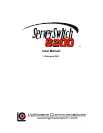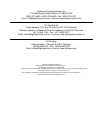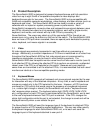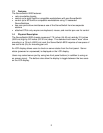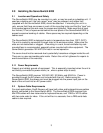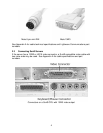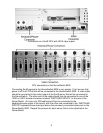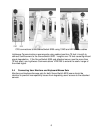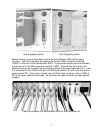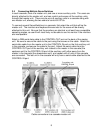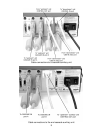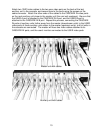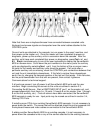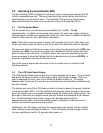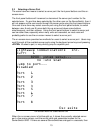3
2.0 Installing the ServerSwitch 8200
2.1 Location and Operational Safety
The ServerSwitch 8200 may be mounted in a rack, or may be used as a desktop unit. If
used as a desktop unit, the rack mount "ears" may be removed, and rubber feet
(supplied with the ServerSwitch 8200) should be attached. If mounting the unit in a
rack, ensure that there are screws in each of the mounting holes and that the "ears" are
firmly seated against the rack once the screws are tightened. Make sure that at least
four inches (10 cm) of space exists behind the rear panel of the ServerSwitch 8200 to
prevent excessive bending of cables. More space may be required depending on the
cables used.
The ServerSwitch 8200 is designed to work in temperatures less than 122°F (50°C).
The unit is cooled by convection through slots in the enclosure sides. Make sure the
slots are not obstructed or clogged. If mounting in a rack, forced ventilation by rack-
mounted fans is recommended, especially when mounted with other equipment. The
ServerSwitch generates 102.4 BTU/hr heat in normal operation.
The cover should not be removed due to potentially hazardous voltages inside the unit.
There are no user-serviceable parts inside. Return the unit to Lightwave for repairs to
avoid cancellation of the warranty.
2.1.1 Power Requirements
Properly and reliably ground all equipment. This is especially important when the unit is
not directly connected to power mains (i.e., when a power strip is used).
The ServerSwitch 8200 requires 100-240 VAC, 30 Watts, and 50/60 Hz. Power is
provided through the AC power cord included with the unit. Before using the
ServerSwitch 8200, the power cord must be plugged into the power input jack on the
back of the unit and into an AC power outlet.
2.2 System Cable Requirements
For most applications, Sun® Servers will have both video and keyboard/mouse cables
directly connected to the ServerSwitch 8200. The ServerSwitch 8200 requires 8-pin
Mini-DIN cables with two male ends for keyboard/mouse, and 13W3 or HD15 cables
with two male ends for video. If the unit will be in a cascade, then a DB9 serial data
cable is also required.



